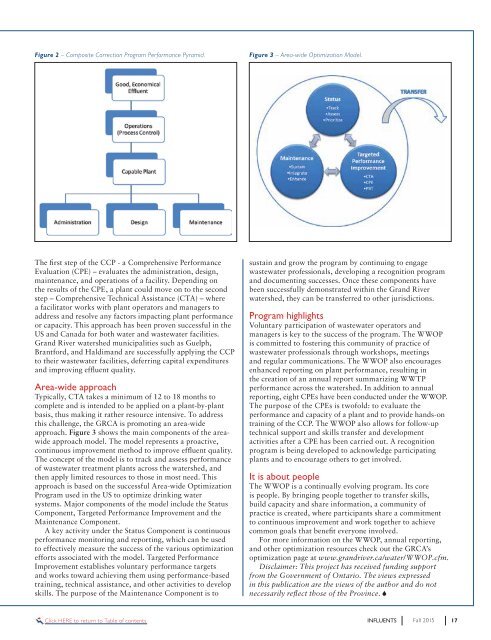lauren@kelman.ca
1YLWYxL
1YLWYxL
You also want an ePaper? Increase the reach of your titles
YUMPU automatically turns print PDFs into web optimized ePapers that Google loves.
Figure 2 – Composite Correction Program Performance Pyramid.<br />
Figure 3 – Area-wide Optimization Model.<br />
The first step of the CCP - a Comprehensive Performance<br />
Evaluation (CPE) – evaluates the administration, design,<br />
maintenance, and operations of a facility. Depending on<br />
the results of the CPE, a plant could move on to the second<br />
step – Comprehensive Techni<strong>ca</strong>l Assistance (CTA) – where<br />
a facilitator works with plant operators and managers to<br />
address and resolve any factors impacting plant performance<br />
or <strong>ca</strong>pacity. This approach has been proven successful in the<br />
US and Canada for both water and wastewater facilities.<br />
Grand River watershed municipalities such as Guelph,<br />
Brantford, and Haldimand are successfully applying the CCP<br />
to their wastewater facilities, deferring <strong>ca</strong>pital expenditures<br />
and improving effluent quality.<br />
Area-wide approach<br />
Typi<strong>ca</strong>lly, CTA takes a minimum of 12 to 18 months to<br />
complete and is intended to be applied on a plant-by-plant<br />
basis, thus making it rather resource intensive. To address<br />
this challenge, the GRCA is promoting an area-wide<br />
approach. Figure 3 shows the main components of the areawide<br />
approach model. The model represents a proactive,<br />
continuous improvement method to improve effluent quality.<br />
The concept of the model is to track and assess performance<br />
of wastewater treatment plants across the watershed, and<br />
then apply limited resources to those in most need. This<br />
approach is based on the successful Area-wide Optimization<br />
Program used in the US to optimize drinking water<br />
systems. Major components of the model include the Status<br />
Component, Targeted Performance Improvement and the<br />
Maintenance Component.<br />
A key activity under the Status Component is continuous<br />
performance monitoring and reporting, which <strong>ca</strong>n be used<br />
to effectively measure the success of the various optimization<br />
efforts associated with the model. Targeted Performance<br />
Improvement establishes voluntary performance targets<br />
and works toward achieving them using performance-based<br />
training, techni<strong>ca</strong>l assistance, and other activities to develop<br />
skills. The purpose of the Maintenance Component is to<br />
sustain and grow the program by continuing to engage<br />
wastewater professionals, developing a recognition program<br />
and documenting successes. Once these components have<br />
been successfully demonstrated within the Grand River<br />
watershed, they <strong>ca</strong>n be transferred to other jurisdictions.<br />
Program highlights<br />
Voluntary participation of wastewater operators and<br />
managers is key to the success of the program. The WWOP<br />
is committed to fostering this community of practice of<br />
wastewater professionals through workshops, meetings<br />
and regular communi<strong>ca</strong>tions. The WWOP also encourages<br />
enhanced reporting on plant performance, resulting in<br />
the creation of an annual report summarizing WWTP<br />
performance across the watershed. In addition to annual<br />
reporting, eight CPEs have been conducted under the WWOP.<br />
The purpose of the CPEs is twofold: to evaluate the<br />
performance and <strong>ca</strong>pacity of a plant and to provide hands-on<br />
training of the CCP. The WWOP also allows for follow-up<br />
techni<strong>ca</strong>l support and skills transfer and development<br />
activities after a CPE has been <strong>ca</strong>rried out. A recognition<br />
program is being developed to acknowledge participating<br />
plants and to encourage others to get involved.<br />
It is about people<br />
The WWOP is a continually evolving program. Its core<br />
is people. By bringing people together to transfer skills,<br />
build <strong>ca</strong>pacity and share information, a community of<br />
practice is created, where participants share a commitment<br />
to continuous improvement and work together to achieve<br />
common goals that benefit everyone involved.<br />
For more information on the WWOP, annual reporting,<br />
and other optimization resources check out the GRCA’s<br />
optimization page at www.grandriver.<strong>ca</strong>/water/WWOP.cfm.<br />
Disclaimer: This project has received funding support<br />
from the Government of Ontario. The views expressed<br />
in this publi<strong>ca</strong>tion are the views of the author and do not<br />
necessarily reflect those of the Province.<br />
Click HERE to return to Table of contents<br />
INFLUENTS<br />
Fall 2015<br />
17


